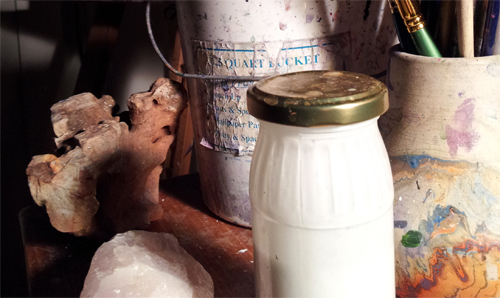
It’s true: one CAN paint anywhere. And paint anywhere I have: on a board propped up by a chair surrounded by jungle. On a canvas taped to a wall in a downtown studio. Small shared spaces where what I called ‘mine’ was merely the space of the stool, the canvas, and the paint… One CAN paint anywhere in the same way that grass pokes through a crack in the pavement, or there’s a bird’s nest on a telephone pole, a flower in a metal pipe poking out from the ground in the ground.
But, given the choice – and when presented with options – I’ve found certain factors provide a more ideal situation. Here’s a list of some… Your mileage may vary…
– Your light should offer a wide throw and not a specific ‘hot spot’. It’s nice if its on a dimmer switch.
– If you are right-handed, the light should be on your left and if you are left-handed, then it should be on your right – otherwise you will be painting in your own shadow the whole time.
– Likewise, if you are right-handed, your water should be on your right – this makes it easiest for dipping your brush as you don’t have to reach across yourself. (Likewise, if you are left-handed…)
– Full-spectrum lightbulbs are best – like the GE Reveal bulbs. Halogen bulbs don’t work for for painting as their color spectrum is terrible.
– If you do not have any place for your water on the side it should be on, then find a small stand or something as it really should be on the same side as your painting hand.
– It’s best if the speakers for your stereo are behind you but the source should be rather close – so you can change the music easily. By having the music behind you, it can better be part of the environment and not compete with your painting. Besides, you need to be at least 10 feet from the speakers to get a decent sense of space to the sound.
– High ceilings are nice as they give an open sensation, however subtle, to the top of the head. It is also easier to work on larger canvases or raise your easel up. If your ceiling is just average height, don’t worry. It’s not worth knocking a hole in the ceiling.
– It’s nice to have a cat next to you while painting. They are gentle and don’t ask much. Dogs… not so much.
– Organize your paints so that you have drawers for them – so they are accessible but out of the way. Keep the tubes for the painting you are working on in a separate drawer from the others so it’s easiest to get to the ones you need quickly when you want them.
– If you paint with acrylics, the best method of water bucket/palate is to use a bucket for the water along with a large lid that fits on the bucket as your palate. This way, when you’re done painting, you can put the lid on your bucket. The water condenses on the underside of the lid where your paints are and keeps them wet. It’s great for a day or two.
– As for brushes: keep a jar or something with the main brushes you use and then keep all the others in other jars that are out of the way.
– Don’t bother with ‘artist grade’ gesso brushes. That’s bullshit.
– Also, if anyone tries to sell you ‘artist grade’ sandpaper, go to a hardware store. Their sand paper will be exactly the same. (Use the sandpaper to smooth up the gesso on the canvas)
– It’s nice to have good windows in your studio. You want to be able to see outside, have a sense of daylight, etc.
– The studio walls should be white. The reflected light of the walls will affect the coloring of your canvas. If you have colored walls, they will tint your canvas a certain color, especially at night, and it will throw you off. You want all your reflected light to be a neutral white.
– A few plants are nice. Besides adding to the general ambiance, they help to clean the air.
– Get a good easel but not one with too many bells and whistles. Bells and whistles tend to get in the way. Most importantly, your easel should be something you can raise and lower without much fuss.
Finally: just paint. Make art. Just do it. Stop thinking about setting something up that’s ideal. The most important thing is that your water is on the side of your painting hand and that your light is on the opposite side and that your canvas is flat and somewhat vertically oriented in front of you and you have something to sit on, even if it’s just a bucket. Everything else is auxiliary to the main goal: making Art.
So get to it. Go make some art.